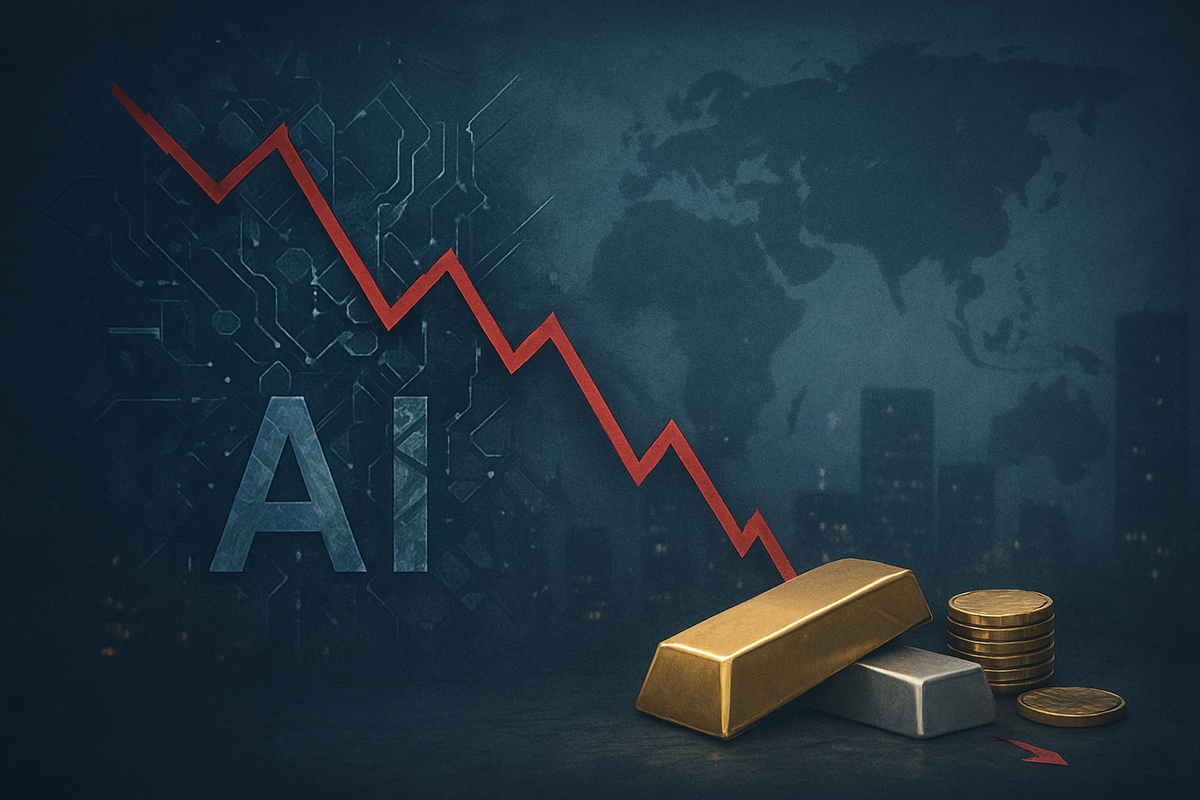
Global financial markets are currently grappling with a potent cocktail of uncertainty, as fears of an "AI bubble" reaching critical mass have triggered a four-day losing streak for global stock markets. This dramatic shift in sentiment, reminiscent of the dot-com bust, has seen investors pull back from speculative assets. While precious metals like gold and silver had experienced a robust rally in the preceding weeks, they too saw a significant retreat on Tuesday, November 18, 2025, as a strengthening US dollar and diminished hopes for aggressive interest rate cuts by the Federal Reserve dampened their appeal.
The confluence of these factors—a broad market sell-off, a re-evaluation of high-flying AI valuations, and a pullback in traditional safe havens—underscores a profound "risk-off" mood pervading the financial landscape. Investors are now navigating a period of heightened volatility, scrutinizing corporate fundamentals, and seeking clarity from central bank policies, all while grappling with the potential for a significant market correction.
Detailed Coverage: The Market's Unsettling Tuesday
Tuesday, November 18, 2025, marked a pivotal and unsettling day for global financial markets. Far from rallying, gold and silver prices experienced a notable decline, retreating from their recent highs. On India's Multi Commodity Exchange (MCX), December gold futures slipped by Rs 1,462 (1.2%) to trade at Rs 1,21,466 per 10 grams, while silver futures eased by Rs 2,562 (1.65%) to Rs 1,52,750 per kilogram. Internationally, spot gold prices fell 0.1% to $4,039.19 per ounce, with US gold futures for December delivery dropping 0.9% to $4,038.60. Spot silver also declined 0.4% to $50 per ounce. This downturn for precious metals marked the fourth consecutive session of international gold price declines, driven primarily by a stronger US dollar and waning hopes for a US Federal Reserve interest rate cut in December.
This precious metals retreat occurred against a backdrop of continued sharp declines in global stock markets, marking the fourth consecutive day of losses. The Dow Jones Industrial Average dropped 584 points (1.3%), the S&P 500 slid 1.1%, and the Nasdaq Composite fell 1.7%. European markets like the FTSE 100, DAX, and CAC also experienced losses, as did Asian markets including Japan's Nikkei 225 and Hong Kong's Hang Seng. This broad market contraction was primarily attributed to escalating fears that the current investment frenzy in Artificial Intelligence (AI) echoes the speculative "DotCom bubble" of the late 1990s.
The timeline leading up to this moment saw gold and silver surge to record highs in October 2025, with gold briefly exceeding $4,300 per ounce and silver touching $54 per ounce, fueled by safe-haven demand and central bank purchases. However, this rally began to cool in late October, with a significant plunge on November 14, 2025, as hopes for a December Fed rate cut faded following a steep sell-off in US AI stocks. By November 15, spot gold prices plummeted over 3% (more than $130), nearing $4030 per ounce, and spot silver declined 4%, approaching $50 per ounce, largely triggered by hawkish comments from US Federal Reserve officials. The market's "risk-off" tone intensified on Monday, November 17, with major stock indexes ending sharply lower, setting the stage for Tuesday's continued declines across equities and the retreat in precious metals.
Key players and stakeholders in this unfolding drama include major tech companies such as Nvidia (NASDAQ: NVDA), Alphabet (NASDAQ: GOOGL), Amazon (NASDAQ: AMZN), and Microsoft (NASDAQ: MSFT), whose high valuations and massive AI capital expenditures are at the heart of the bubble fears. Central banks, particularly the US Federal Reserve (Fed), are also crucial, with their hawkish stance on interest rates directly impacting precious metals and overall market sentiment. Investor groups, including tech billionaires like Peter Thiel and short-sellers like Michael Burry, are actively influencing the market through their positions and public statements on AI valuations. Initial market reactions beyond price movements include analyst commentary broadly observing "risk being taken off the table" and a strategic shift in institutional investment focus, with Bank of America naming gold miners as its number one investment theme of 2025, ahead of even AI, despite the current dip in physical gold.
Companies Navigating the AI Bubble and Market Volatility
The current market conditions are creating a clear divide between potential winners and losers, forcing companies and investors to adapt rapidly.
On the losing side are many of the Tech Giants Heavily Invested in AI and AI pure-plays. Companies that have seen massive valuation increases due to the AI boom are now facing significant pressure. Nvidia (NASDAQ: NVDA), the leading AI chipmaker, has been at the epicenter of the AI rally but has experienced significant sell-offs, with its shares down 7.9% in November. Palantir Technologies (NYSE: PLTR) also slumped almost 8%, partly due to being targeted by renowned short-seller Michael Burry. Other "Magnificent Seven" components like Microsoft (NASDAQ: MSFT), Meta Platforms (NASDAQ: META), Amazon (NASDAQ: AMZN), Tesla (NASDAQ: TSLA), and Alphabet (NASDAQ: GOOGL/GOOG) have seen their stocks fall, with concerns over their substantial capital expenditures in AI development raising questions about delayed returns. Companies like Snowflake (NYSE: SNOW), Roku (NASDAQ: ROKU), and AMD (NASDAQ: AMD) are also vulnerable due to high revenue multiples and ties to hyperscaler procurement cycles. The Cryptocurrency Market has also been hit hard, with Bitcoin (CRYPTO: BTC) falling below $90,000, impacting companies like Coinbase (NASDAQ: COIN).
Gold and Silver Mining Companies are also facing headwinds due to the recent retreat in precious metals prices from their record highs. Lower gold and silver prices directly squeeze revenues and profit margins for producers such as Newmont Corporation (NYSE: NEM), Barrick Gold Corporation (NYSE: GOLD), Pan American Silver Corp. (NASDAQ: PAAS), and First Majestic Silver Corp. (NYSE: AG). Companies with higher operating costs or substantial debt loads are particularly vulnerable to decreased earnings, negative stock valuations, and potential project delays. Short-term speculators and leveraged traders in precious metals have likely faced substantial losses due to sharp price corrections.
Conversely, some companies are proving resilient or even winning. Defensive Sectors like healthcare, consumer staples, government & defense services, and utilities tend to be more robust during market volatility as demand for their products and services remains constant. Within tech, companies with strong fundamentals or unique positioning are faring better. Apple (NASDAQ: AAPL), for instance, is seen as an "ecosystem monetizer with AI optionality," benefiting indirectly from AI without the same high capital intensity. Broadcom (NASDAQ: AVGO) has seen its AI-oriented chip sales more than triple, offsetting weaker sales in other segments. Royalty and Streaming Companies in precious metals, such as Wheaton Precious Metals (NYSE: WPM) and Franco-Nevada Corporation (NYSE: FNV), offer a more insulated way to gain exposure, as they are less exposed to the direct impact of fluctuating production costs. Finally, simply holding Cash remains a defensive asset, especially with elevated interest rates.
Wider Significance: Echoes of the DotCom Era
The current market turmoil holds wider significance, fitting into broader industry trends and drawing stark comparisons to historical speculative manias, most notably the DotCom bubble of the late 1990s. The parallels are striking: both periods are characterized by a major technological innovation (the internet then, AI now) driving immense investor enthusiasm and speculative investment. In both eras, investors have been willing to overlook traditional financial metrics and current losses, pricing potential over performance. Rapid valuation growth, particularly in tech stocks, has been a hallmark of both periods, with concerns about "circular financing" potentially inflating values.
However, crucial differences exist. Today's dominant tech companies, such as Nvidia (NASDAQ: NVDA), Microsoft (NASDAQ: MSFT), and Alphabet (NASDAQ: GOOGL), generally possess stronger underlying fundamentals, proven business models, and robust balance sheets, unlike many unprofitable DotCom startups. While elevated, current AI valuations are generally less extreme than the peak of the DotCom bubble, and the demand for AI compute is seen as more real-world driven. The current surge is also led by powerful incumbents who can sustain years of losses, potentially concentrating market power but reducing systemic risk compared to the many fragile startups of the DotCom era.
A significant market correction or an "AI bubble" burst would have substantial ripple effects. Smaller AI companies and startups, heavily reliant on venture capital, would face immense funding difficulties, leading to consolidation or innovation slowdowns. Even established tech giants could see substantial declines in market value. The entire supply chain supporting AI development would likely experience reduced demand. From a regulatory standpoint, growing apprehension over AI valuations is intensifying calls for scrutiny. Regulators are concerned about AI's potential to amplify systemic risks, facilitate market manipulation through "herding behavior," and present transparency challenges due to opaque "black-box" algorithms. Policymakers are urged to fund AI projects that deliver tangible productivity and social benefits, with the US Securities and Exchange Commission (SEC) actively studying AI's risks and considering regulatory proposals. Historically, such bubbles, from Tulip Mania to the US Housing Bubble, share common characteristics of speculative excess followed by a crash, but also show that underlying technologies can eventually deliver significant benefits once excesses are purged.
What Comes Next: Navigating the Uncertainty
The path forward for financial markets, given the current AI bubble fears, ongoing stock market declines, and the recent retreat in precious metals, appears uncertain and complex.
In the short-term (next 12-18 months), continued market volatility is highly probable, especially within the tech sector as AI valuations are scrutinized. A sector rotation from high-growth tech to more defensive, value-oriented stocks is likely. Gold and silver may remain in a consolidation phase, with their movements tied to the dollar's strength and Federal Reserve policy. Corporate earnings growth, rather than valuation expansion, is expected to drive market returns, suggesting more modest overall gains. Central banks are anticipated to maintain a cautious approach to interest rate adjustments.
For the long-term (beyond 18 months), despite current bubble fears, AI is widely expected to be a transformative technology, potentially spurring long-term productivity and economic growth, though the realization of these benefits may take longer than currently envisioned. Market leadership could broaden beyond the current mega-cap tech companies. Persistent inflationary pressures, global economic uncertainties, and geopolitical tensions could reinforce the role of precious metals as a hedge. Long-term forecasts for gold remain robust, driven by central bank demand and its role against financial system fragmentation.
Strategic pivots for companies include a renewed focus on operational value creation, digital modernization, and supply chain optimization. Investors should prioritize diversification across asset classes, geographic regions, and sectors, maintaining a long-term perspective, and focusing on companies with strong fundamentals and reasonable valuations. Emerging markets present both opportunities and challenges; while offering attractive valuations and domestic demand, they remain vulnerable to US policy uncertainty and global macroeconomic headwinds.
Several potential scenarios could unfold: a "soft landing" with an AI correction but no deep recession, a "hard landing" with a dramatic AI bubble burst leading to a deeper stock market decline and potential recession, or a stagflationary environment characterized by persistent inflation and stagnant growth. In all scenarios, the role of central banks is critical, as they navigate interest rate policies to balance inflation control with economic growth, and potentially intervene with liquidity injections in crises. Investor sentiment, currently "risk-off," will continue to be a dominant factor, driving capital flows towards safe havens like precious metals during periods of stress.
Comprehensive Wrap-up: A Market in Transition
The current financial climate, as of November 18, 2025, is defined by a profound transition, where the exuberance of the AI boom is clashing with the realities of market fundamentals and monetary policy. The intensifying "AI bubble" fears, coupled with a four-day global stock market slide, signal a critical re-evaluation of investment strategies. The retreat in gold and silver, following an earlier rally, highlights the immediate influence of a stronger US dollar and the Federal Reserve's "higher for longer" interest rate stance.
Key takeaways include the broad market sell-off driven by AI valuation concerns, the significant pullback in precious metals from recent highs, and the clear shift towards a "risk-off" investor sentiment. The market is assessing whether the current AI investment frenzy is a sustainable technological revolution or a speculative bubble akin to the DotCom era, with many prominent figures urging caution.
Moving forward, the market is expected to remain volatile. The tech sector, particularly AI-heavy stocks, will be under intense scrutiny, with upcoming earnings reports from bellwethers like Nvidia (NASDAQ: NVDA) potentially acting as catalysts. Precious metals are likely to continue their consolidation phase, with their performance closely tied to the dollar's strength and the evolving outlook on interest rates. However, their long-term role as a hedge against inflation and geopolitical instability could provide underlying support.
The significance and lasting impact of this period could be profound. It may redefine leadership within the technology sector, distinguishing between genuinely transformative AI applications and speculative ventures. The Fed's sustained commitment to inflation control will influence global capital flows and corporate strategies for the foreseeable future. This dynamic environment will test investor resilience and strategic acumen, ultimately shaping the market's landscape for years to come.
Investors should watch for several key indicators in the coming months. Closely monitor Federal Reserve communications and economic data releases for any shifts in interest rate policy. Scrutinize tech and AI investments, prioritizing companies with clear paths to profitability and robust fundamentals. Enhance portfolio diversification beyond concentrated or speculative assets, considering rebalancing towards undervalued sectors. Re-evaluate precious metals for long-term hedging, recognizing potential accumulation opportunities during current dips, but also preparing for continued short-term volatility. Finally, stay abreast of geopolitical developments, as global events can swiftly alter market sentiment and safe-haven demand.
This content is intended for informational purposes only and is not financial advice






